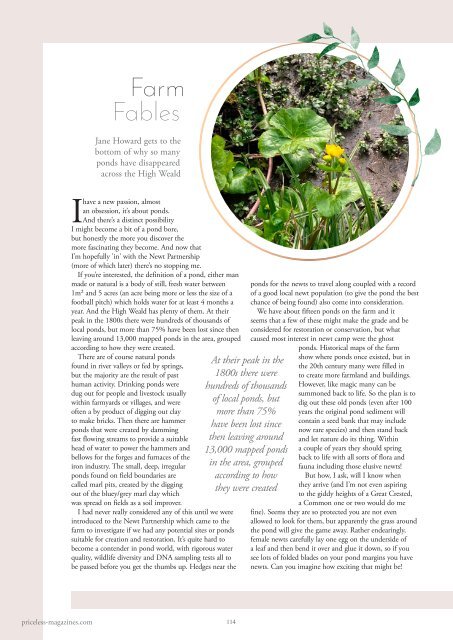Surrey Homes | SH111 | April 2024 | Garden Supplement inside
The lifestyle magazine for Surrey - Inspirational Interiors, Fabulous Fashion, Delicious Dishes
The lifestyle magazine for Surrey - Inspirational Interiors, Fabulous Fashion, Delicious Dishes
Create successful ePaper yourself
Turn your PDF publications into a flip-book with our unique Google optimized e-Paper software.
Jane Howard gets to the<br />
bottom of why so many<br />
ponds have disappeared<br />
across the High Weald<br />
I<br />
have a new passion, almost<br />
an obsession, it’s about ponds.<br />
And there’s a distinct possibility<br />
I might become a bit of a pond bore,<br />
but honestly the more you discover the<br />
more fascinating they become. And now that<br />
I’m hopefully 'in' with the Newt Partnership<br />
(more of which later) there’s no stopping me.<br />
If you’re interested, the definition of a pond, either man<br />
made or natural is a body of still, fresh water between<br />
1m² and 5 acres (an acre being more or less the size of a<br />
football pitch) which holds water for at least 4 months a<br />
year. And the High Weald has plenty of them. At their<br />
peak in the 1800s there were hundreds of thousands of<br />
local ponds, but more than 75% have been lost since then<br />
leaving around 13,000 mapped ponds in the area, grouped<br />
according to how they were created.<br />
There are of course natural ponds<br />
found in river valleys or fed by springs,<br />
but the majority are the result of past<br />
human activity. Drinking ponds were<br />
dug out for people and livestock usually<br />
within farmyards or villages, and were<br />
often a by product of digging out clay<br />
to make bricks. Then there are hammer<br />
ponds that were created by damming<br />
fast flowing streams to provide a suitable<br />
head of water to power the hammers and<br />
bellows for the forges and furnaces of the<br />
iron industry. The small, deep, irregular<br />
ponds found on field boundaries are<br />
called marl pits, created by the digging<br />
out of the bluey/grey marl clay which<br />
was spread on fields as a soil improver.<br />
I had never really considered any of this until we were<br />
introduced to the Newt Partnership which came to the<br />
farm to investigate if we had any potential sites or ponds<br />
suitable for creation and restoration. It’s quite hard to<br />
become a contender in pond world, with rigorous water<br />
quality, wildlife diversity and DNA sampling tests all to<br />
be passed before you get the thumbs up. Hedges near the<br />
At their peak in the<br />
1800s there were<br />
hundreds of thousands<br />
of local ponds, but<br />
more than 75%<br />
have been lost since<br />
then leaving around<br />
13,000 mapped ponds<br />
in the area, grouped<br />
according to how<br />
they were created<br />
ponds for the newts to travel along coupled with a record<br />
of a good local newt population (to give the pond the best<br />
chance of being found) also come into consideration.<br />
We have about fifteen ponds on the farm and it<br />
seems that a few of these might make the grade and be<br />
considered for restoration or conservation, but what<br />
caused most interest in newt camp were the ghost<br />
ponds. Historical maps of the farm<br />
show where ponds once existed, but in<br />
the 20th century many were filled in<br />
to create more farmland and buildings.<br />
However, like magic many can be<br />
summoned back to life. So the plan is to<br />
dig out these old ponds (even after 100<br />
years the original pond sediment will<br />
contain a seed bank that may include<br />
now rare species) and then stand back<br />
and let nature do its thing. Within<br />
a couple of years they should spring<br />
back to life with all sorts of flora and<br />
fauna including those elusive newts!<br />
But how, I ask, will I know when<br />
they arrive (and I’m not even aspiring<br />
to the giddy heights of a Great Crested,<br />
a Common one or two would do me<br />
fine). Seems they are so protected you are not even<br />
allowed to look for them, but apparently the grass around<br />
the pond will give the game away. Rather endearingly,<br />
female newts carefully lay one egg on the underside of<br />
a leaf and then bend it over and glue it down, so if you<br />
see lots of folded blades on your pond margins you have<br />
newts. Can you imagine how exciting that might be!<br />
priceless-magazines.com 114

















